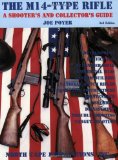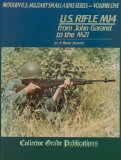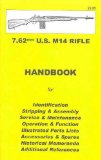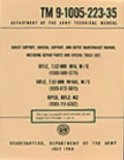
The M14 7.62mm rifle is a magazine-fed, gas operated shoulder weapon, designed primarily for semi-automatic fire. It was the standard U.S. military service rifle until it was replaced in the late-1960s by the 5.56mm M16A1 rifle.
M14 Specifications
| Length | 44.14 inches (112.12 centimeters) |
|---|---|
| Length of Barrel | 22 inches (55.88 centimeters) |
| Weight (empty magazine) | 8.7 pounds (3.95 kilograms) |
| Weight (full magazine and sling) | 11.0 pounds (5.0 kilograms) |
| Bore diameter | 7.62mm |
| Maximum effective range | 1,509.26 feet (460 meters) |
| Muzzle velocity | 2,800 feet (853 meters) per second |
| Cyclic rate of fire | 750 rounds per minute |
| Magazine capacity | 20 rounds |
Articles on the M14
Collecting and Shooting the 7.62-MM Rifle M14 and M1A – History
The M14 was conceptually designed during the latter part of WWII when the Garand was being evaluated due to perceived shortcomings. The M1 Garand is a fine and functional battle rifle, one of the finest. The U.S. military wanted a lighter weapon with a detachable, higher capacity magazine (20), the ability to launch grenades, utilize a bipod, and have full-auto capability.
Collecting and Shooting the 7.62-MM Rifle M14 and M1A – Operations
M14 Manuals
U.S. Army Technical Manual TM 9-1005-223-35
Department of the Army Technical Manual: Direct Support and General Support Maintenance Manual including Repair Parts and Special Tools Lists (including depot maintenance repair parts and special tools): Rifle, 7.62-MM, M14, W/E (1005- 589-1271); Rifle, 7.62-MM, M14A1, W/E (1005-072- 5011); Bipod, Rifle, M2 (1005-711-6202).
Books on the M14

The M14-Type Rifles: A Shooter’s and Collector’s Guide
The M14 was the last large caliber rifle adopted by the U.S. military. It was derived from, and replaced the M1 Garand of World War II and Korean War fame. It in turn was replaced by the 5.56 mm M16 in the early stages of the War in Vietnam. Although the M14 lasted less then 10 years as the military service rifle, its effect was overwhelming in civilian and military match target shooting for thirty year, especially at ranges exceeding 600 yards, and in the development of military and paramilitary sniper rifles.
The M14-Type Rifles presents both the military and civilian side of this fine rifle along with a complete run-down on non-military clones of the M1A variety. The M14 was built for the U.S. military at the Springfield National Armory, at Winchester Repeating Firearms, Harrington and Richardson and TRW. Civilian versions have been built by a host of companies including Springfield, Inc., Armscorp and others. Very fine receivers for building do-it-yourself match target rifles have been manufactured by, among others, Enterprise Arms, Smith, Armscorp and DPS. Topics covered include a complete examination of parts and means of identification by manufacturer, the development, manufacture and use of the M14, the development of the M21 and M25 sniper rifles and their telescopic sights and mounts which are covered in a separate chapter, and the National Match M14 and M1A target rifles.
The book provides a history of the development of the civilian version of the M14 and the civilian version, the M1A,by its various manufacturers, including those in both Chinas. A chapter is given over to accurizing the M1A rifle for “do-it-yourselfers and for custom rifle smiths and the U.S. Army’s National Match Specifications and building techniques are listed. Ammunition selection and preparation for match shooting and shooting techniques and positions are detailed. The book is heavily illustrated with photographs and line drawings. Also included are a list of manufacturers, parts and accessory suppliers and custom rifle smiths capable of building less than 1 minute of angle rifles.
In the preparation of this book, manufacturer’s of both of complete M1A rifles and of M1A receivers were reviewed and their products tested. Three M14-type rifles were then built by well- known custom rifle smiths. The complete procedures are laid out along with tips and cautions so that the reader so inclined can build his or her own service or target M14-type rifle for competition or target shooting.

US Rifle M14 – from John Garand to the M21
I bought this book second hand of Amazon.com, and did not know quite what to expect. However, ever since it showed up in the mail a few days ago, I have not stopped reading it! Quite simply, there is so much interesting information about the M14 in this book, that the M14 enthusiastic will learn a about the trials and tribulations of the Army Ordnance’s last rifle. In this book, Stevens traces out the long and tedious development of the M14 rifles. He covers everything from the early experiments with modified M1 Garand (which comprises about half the book) to the evaluations of the M14 as well as the development of the M21.
Starting with the M1E series, Stevens traces the lineage of the M14 through the various test and changes made on the M1 Garand. Detailed reports on the improvement and subsequent evolution of the M1 rifle are reproduced in this book, giving insight into both the ingenuity of the engineers as well as the unfortunate politics that would plague the M14’s future. Even included is a reprint of a preliminary Technical Manual on the T20E2; a rifle with remarkable resemblance to the M14 – produced in 1945!
Stevens also describes in detail the selection and production of the M14 rifle. Included are rather heart-wrenching details on the competition between the T44 rifle (soon to be the M14) and the T48 rifle (FN), which shows how close America came to adopting the T48. Stevens spares no effort to include the controversy (a lot was political) that surrounded the M14, and includes reports and findings that seemed to damn the M14 as an inferior rifle the M1 Garand, which late lead the push to adopt the AR-15. While I’m sure more than one M14 enthusiast will feel a bit sad as they read these reports (I sure did!), Stevens also describes the triumphs of the M14. We see a snap shot into the production of the M14 by Springfield, Winchester, H&R, and TRW and how they overcame the problems they faced (some like TRW did better than others), as well as a detailed account of the successful creation of the NM M14 and subsequent M21.
I had always wondered how the M14 came to be, and throughout the book, I found myself saying “Oh that’s how they changed the M1 to the M14!” While admittedly, I am a total M14 amateur, I would think that even those with a lot of knowledge on the M14 would learn something from this book. Stevens has done a wonderful job of collecting numerous reports and putting them along with interesting and rare pictures into a cohesive history of the M14. Thanks to this book, the next time I shoulder a M1A or other M14 Clone, I will appreciate the time, effort, and dedication that went into producing that last American battle rifle.

The M14 owner’s guide and match conditioning instructions
Scott Duff’s book on the M14 combines the aspects of both field and technical manuals. Sections include an overview / history of the M14 from it’s early conception phase, (the T44, around the mid 1940’s) to the XM25, an M14 sniper rifle utilized by U.S. Army Special Forces and U.S.N. Seal teams in Grenada and Desert Storm. Also Chapters on Assembly / Disassembly, Maintainence, Zeroing the weapon, and an excellent section on match conditioning the weapon. The book is well written, with a light, easily read-able style. It covers many more aspects of this rifle than any other single text in print. The only potential drawbacks are that the tips given on subjects ranging from cleaning to handloads don’t go into very much detail. They go into enough detail to get the point across, but often not enough to fully explain the reasoning behind the suggestion. The other fault is that some of the other explainations left my head spinning; lack of familiarity with many of the part names the guilty culprit. The best aspect of this book is the match conditioning instructions. The section is a veritable recipe for an awesome rifle.

U.S. M14 Rifle Assembly, Disassembly Manual 7.62mm
Ideal workshop reference for stripping & assembly with exploded parts drawings, specifications, service accessories, historical information and recommended reading references. And ideal workbook for shooters and collectors alike. 36 pp, over 60 photos & line drawings. Triple saddle-stitched binding with durable plastic laminated cover makes this an ideal workshop guide.

Technical Manual For The M14
U.S. Army Technical Manual TM 9-1005-223-35. Department of the Army Technical Manual: Direct Support and General Support Maintenance Manual including Repair Parts and Special Tools Lists (including depot maintenance repair parts and special tools): Rifle, 7.62-MM, M14, W/E (1005- 589-1271); Rifle, 7.62-MM, M14A1, W/E (1005-072- 5011); Bipod, Rifle, M2 (1005-711-6202).